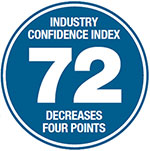- NEWS
- PROJECTS
- BUSINESS
- TALENT
- REGIONS
- TECH
- PRODUCTS
- IDEAS
- COSTS
- LISTS
- INFOCENTERS
- EVENTS
- Award of Excellence
- Best of the Best Project Awards
- FutureTech
- Groundbreaking Women in Construction EAST
- Groundbreaking Women in Construction WEST
- Global Best Projects Awards
- LA Infrastructure Forum
- NY/NJ Infrastructure Forum
- Regional Best Projects
- Seattle Infrastructure Forum
- Top 25 Newsmakers
- Upcoming Events
- Webinars
- MORE
You have 0 Articles Left This Month. Join ENR UNLIMITED for Full Access.
 Most executives believe the market will continue to grow for another year, but many believe the boom will begin to level off in 2019 unless the Trump administration shows more progress on its pro-growth initiatives.
Most executives believe the market will continue to grow for another year, but many believe the boom will begin to level off in 2019 unless the Trump administration shows more progress on its pro-growth initiatives.